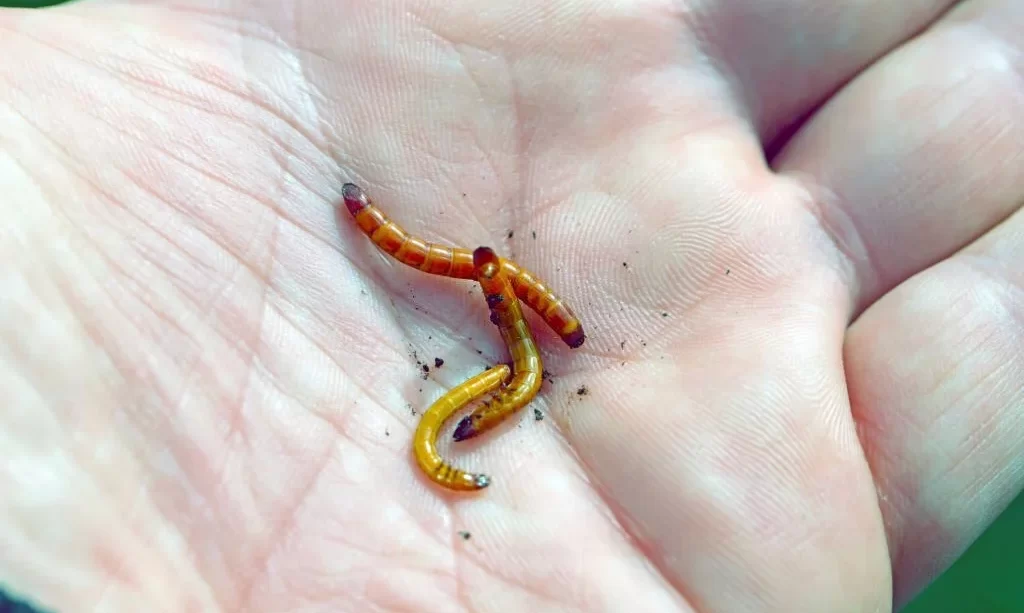In the hidden world beneath our feet, a fascinating group of creatures known as wireworms quietly goes about its subterranean existence. These small, slender insects, often encountered by gardeners and farmers, have piqued curiosity regarding their potential impact on humans. Wireworms, with their elongated bodies and preference for dwelling beneath the soil’s surface, prompt the question: Are they harmful to humans in any way? To unravel this mystery, we embark on an exploration of these enigmatic underground inhabitants.
Wireworms
To comprehend the potential impact of wireworms on humans, it is essential to first grasp what these creatures are and how they fit into the intricate tapestry of the natural world. Wireworms, despite their name, are not worms but the larval stage of click beetles, a type of insect. These larvae possess long, slender bodies and a hard exoskeleton, characteristics that distinguish them from true worms.
Their preferred habitat lies beneath the soil’s surface, where they engage in a rather peculiar lifestyle. Wireworms are voracious feeders, primarily subsisting on organic matter and plant roots. Their subterranean presence makes them elusive to the human eye, often escaping notice until they reveal their presence through damage to plants.
While their impact on agriculture is well-documented, their role in ecosystems and any potential harm they might pose to humans directly require further investigation. As we delve into the world of wireworms, we aim to separate fact from fiction and uncover the extent of their influence on our lives.
The Agricultural Perspective: Wireworms and Crop Damage
One of the primary arenas where wireworms gain notoriety is agriculture. These underground inhabitants can wreak havoc on crops, making them a significant concern for farmers.
Wireworms, in their larval stage, feed voraciously on plant roots and underground portions of crops. This feeding behavior can lead to stunted growth, reduced crop yields, and even plant death. For farmers, wireworm damage can translate into economic losses and reduced agricultural productivity.
Understanding and managing wireworm infestations in agriculture is crucial. Farmers employ various strategies to mitigate the impact of these subterranean pests, ranging from crop rotation and planting resistant crop varieties to the use of chemical and biological control measures. The economic significance of wireworm damage underscores the importance of effective wireworm management practices in modern agriculture.
Wireworms in Gardens and Lawns: Potential Nuisance
Beyond the realm of large-scale agriculture, wireworms can occasionally find their way into home gardens and lawns. In such settings, they can pose localized challenges to gardeners.
Wireworms may damage plant roots in home gardens, causing stunted growth and wilted foliage. While their impact in domestic settings is typically limited in scale compared to commercial agriculture, they can be a source of frustration for gardeners who encounter them.
Gardeners facing wireworm issues may employ various methods to protect their plants, including soil testing to confirm wireworm presence, using physical barriers, and practicing crop rotation. While wireworms can be a nuisance in gardens and lawns, their effects are usually manageable with proper gardening practices.
As we explore wireworms from both the agricultural and gardening perspectives, we gain a clearer understanding of their impact on cultivated plants. However, the question remains: Do wireworms directly harm humans? Let’s delve further into this inquiry to provide a comprehensive answer.
Wireworms and Human Health: Limited Concerns
When it comes to the potential harm wireworms may pose to humans, the concerns are generally limited. These underground inhabitants are primarily focused on their subterranean world of feeding on organic matter and plant roots. As such, direct interactions between wireworms and humans are rare.
Handling wireworms with bare hands may, in some cases, lead to minor skin irritation or discomfort due to the sharpness of their exoskeletons. However, serious health risks associated with wireworms are exceedingly rare.
Wireworms are not known to transmit diseases, and they do not possess any significant physical attributes that would make them harmful to humans. Unlike some insects that can sting, bite, or carry pathogens, wireworms maintain a relatively innocuous presence in the context of human health.
Wireworm Control Measures
For those who encounter wireworms in agricultural or gardening settings and seek to manage their impact on cultivated plants, various control measures are available.
In Agriculture:
- Farmers often employ integrated pest management (IPM) strategies to address wireworm infestations. This approach combines multiple tactics to minimize pest damage while reducing the use of chemical pesticides.
- Crop rotation, where wireworm-prone crops are not planted in the same fields consecutively, can help disrupt the wireworm life cycle.
- Some chemical and biological control options exist, although their effectiveness may vary depending on local conditions and specific wireworm species.
In Gardens and Lawns:
- Gardeners can conduct soil tests to confirm the presence of wireworms and assess the extent of the infestation.
- Physical barriers, such as wireworm-resistant planting containers or raised beds, can deter wireworms from accessing plants.
- Practicing good gardening hygiene, including removing crop debris and rotating crops, can help manage wireworm populations.
Conclusion
In our exploration of wireworms and their potential harm to humans, we find that these subterranean inhabitants are primarily a concern in the realms of agriculture and gardening. They are known for their ability to damage crops and plant roots, posing economic challenges for farmers and localized nuisances for gardeners.
However, in terms of direct harm to humans, wireworms are generally considered to be of limited concern. While they may cause minor skin irritation when handled, they do not pose significant health risks. In comparison to other insects that can bite, sting, or transmit diseases, wireworms maintain a relatively benign presence in the human sphere.
As we wrap up our investigation into wireworms, it becomes clear that understanding their behavior and implementing effective control measures in agriculture and gardening settings is essential. By doing so, we can minimize their impact on cultivated plants while acknowledging their status as intriguing but generally harmless denizens of the underground world.



